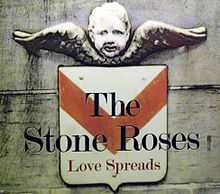Love Spreads
| "Love Spreads" | ||||
|---|---|---|---|---|
 | ||||
| Single by The Stone Roses | ||||
| from the album Second Coming | ||||
| Released | November 1994 | |||
| Format | CD, cassette, vinyl record 12" | |||
| Genre | Indie rock,[1][2] blues rock | |||
| Length | 5:46 | |||
| Label | Geffen | |||
| Producer(s) | Simon Dawson | |||
| The Stone Roses singles chronology | ||||
| ||||
"Love Spreads" is a song by The Stone Roses, released in November 1994 as the first single from their second album Second Coming. The record was a number two hit in the UK, the highest peak for any song by the band, as well as the only Stone Roses song to chart on the Billboard Hot 100 Airplay, charting at number 55, making the song their most commercially successful track. It showcased a bolder, edgier direction for the Roses' sound, especially John Squire's Led Zeppelin-tinged guitars.[citation needed]
Lyrics
The lyrics, written by John Squire, are an attack on the traditional image of Jesus. Squire portrays the crucifixion of the Messiah with a black woman on the cross. This continued the band's theme of questioning the depiction of Christ, which first appeared on the track, "I Am The Resurrection."[citation needed]
Cover art
John Squire designed the "Love Spreads" cover, using a photograph of one of the four stone cherubs on the Newport Bridge in Newport, South Wales.[3] The cherubs on the bridge are modelled after Newport's coat of arms, which contains a cherub with winged sea lions. The cherub design was subsequently used on many pieces of Second Coming merchandise. Some of the bridge's cherubs were subsequently ripped from their mounts, allegedly taken as souvenirs by fans of the band.
Music video
There are two music videos for "Love Spreads." The original UK version, directed by Mike Clark and the Stone Roses,[4] consisted of home footage. There are scenes of Mani, Squire, and Brown dressed as a chicken, the devil, and Death respectively. These scenes were interspliced with hidden images.
Geffen and MTV were unsatisfied with the quality of the first video, so Steven Hanft at Propaganda Films directed a second video for American audiences.[4][5] This video featured the band in front of oil rigs mining for gold. Beck makes a cameo appearance as a gold prospector. In this video, Squire incorporated artistic influences from the likes of Andy Warhol and Andrew Wyeth. Fitting with the crucifixion theme of the song, Squire also opens the video sitting on a donkey, just like Jesus entering Jerusalem on Palm Sunday.[citation needed]
Responses
Bobby Gillespie of Primal Scream hailed the song "as the greatest comeback single ever." In May 2007, NME magazine placed "Love Spreads" at number 44 in its list of the 50 Greatest Indie Anthems Ever.
Legacy
A re-recorded version of "Love Spreads" was used on The Help Album (a compilation of songs for the charity War Child). It was also used in the season 4 episode of CSI: Crime Scene Investigation, "Invisible Evidence" and in a season 5 episode of Entourage, "Return to Queens Boulevard."
The song is featured in the music videogame Guitar Hero World Tour, appearing in the final bonus set in career mode. It is also available as a downloadable track for the music video game series Rock Band.
The song is also heavily used in Mega Channel Greek dramatic series I Zoi Tis Allis at end credits
Track listing
7": [Geffen GFS 84]
- "Love Spreads" (5:46)
- "Your Star Will Shine" (2:56)
12": [Geffen GFST 84]
- "Love Spreads" (5:46)
- "Your Star Will Shine" (2:56)
- "Breakout" (6:04)
- "Groove Harder" (4:26)
CD: [Geffen GFSTD 84]
- "Love Spreads" (5:46)
- "Your Star Will Shine" (2:56)
- "Breakout" (6:04)
References
- ↑ "The Stone Roses - The Inside Story...". Clash. Retrieved 5 April 2011.
- ↑ "BBC - Seven Ages of Rock "What the World Is Waiting For"". Seven Ages of Rock. 2007. Retrieved 5 April 2011.
- ↑
- ↑ 4.0 4.1 A.J Jacobs (28 April 1995). "Broadcast No's: Music Videos You'll Never See". Entertainment Weekly. Retrieved 4 December 2011.
- ↑ "Production Notes". Billboard. 8 April 1995. p. 53.
| |||||||||||||||||||||||